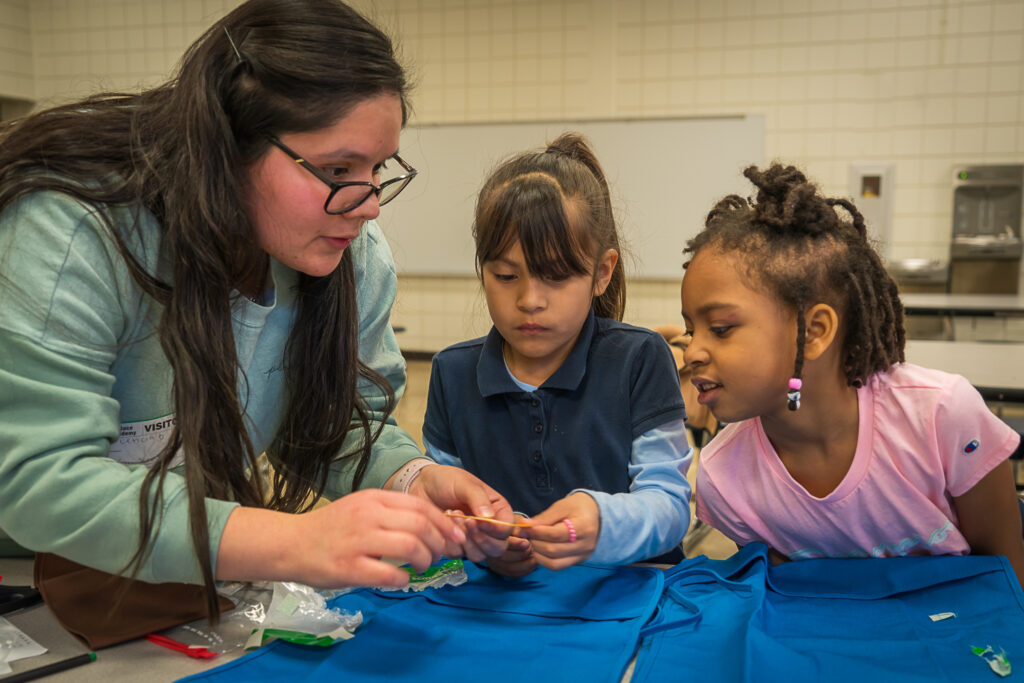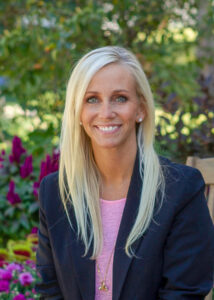2022 Annual Report:
As CEO of Girl Scouts of Central Indiana, Danielle Shockey regularly checks data related to the well-being of youth—especially girls. Much of the research reveals troubling trends; among them are an increase in the number of youth experiencing anxiety, depression and suicidal tendencies.
Yet, she also is familiar with another data set—one that shows the impact that youth organizations can have on a young person’s development and sense of well-being, which leads to higher rates of high school graduation, college attendance and gainful employment. That type of research gives Shockey hope that Girl Scouts and other youth-serving organizations can make inroads in providing the support children and teens need for improved well-being.
Through Lilly Endowment’s initiative, Strengthening Youth Programs in Indiana: National Organizations and Affiliates, the Girl Scouts of Central Indiana and five other Girl Scout councils across the state, in concert with the Girl Scouts of the United States of America (GSUSA), are collaborating to better serve girls in Indiana. In 2022, GSUSA was one of nine national youth-serving organizations with affiliates and chapters in communities throughout Indiana that received planning grants. The $100,000 planning grants helped the organizations understand better the perspectives and challenges of youth in Indiana and design strategic approaches to strengthen their programs and reach more youth, especially youth who have been underserved in the past. The nine organizations then received implementation grants, which are helping them respond to the needs of Indiana youth in a variety of ways. They are developing new programs for teenagers, improving support for students facing mental health challenges, addressing barriers that prevent young people from accessing their programs and renovating buildings and constructing new facilities.
Identifying barriers
An important aspect of the Strengthening Youth Programs in Indiana initiative was a planning grant that helped Girl Scout leaders across Indiana gain crucial insights about what keeps children and teens from joining youth organizations. According to Shockey, Indiana affiliates reach less than five percent of the population that could join Girl Scouts.
“The grant gave us the opportunity to go out into the communities to reach families that we want to serve better,” Shockey says. “But, instead of showing up assuming they want to be in Girl Scouts, we asked questions like, ‘How can we, together, help Hoosier girls, specifically those you care about, to have a healthy and happy childhood? A supportive teen experience? And how can we support you and this community?’
“Before the planning grant, we never came together to ask, ‘How can we do this differently or go at this in a way that we’ve never done before?’,” Shockey says. “The planning grant allowed us to partner with research experts, people who could help us with understanding the barriers that keep girls from participating.”

Letecia Bernal works with Girl Scouts in Troop 9073.
The other Girl Scout councils included in the collaborative are the Girl Scouts of Greater Chicago & Northwest Indiana, Girl Scouts of Kentuckiana, Girl Scouts of Northern Indiana Michiana, Girl Scouts of Southwest Indiana, and Girl Scouts of Western Ohio.
“Thanks to the collaboration across six Indiana-serving Girl Scout councils, we are reaching a comprehensive population of girls across regions and demographics,” says Sofia Chang, who was CEO of GSUSA at the time the Strengthening Youth Programs in Indiana initiative began. “This allows us to gain a more holistic view of all the challenges to participation so that we can meet the needs of all girls in Indiana and then scale those learnings nationally.”
Listening to the voices of youth and their families
Research and listening sessions funded by the Girl Scouts planning grant provided comprehensive insights that informed an implementation grant proposal from GSUSA. In September 2022, the national organization received a $15 million grant to support a three-year collaboration among Girl Scout councils in Indiana. During that grant period, which runs through September 2025, the coalition will serve as an incubator of creative solutions on how to reach and better support Hoosier girls and families in all 92 Indiana counties. Across the state, regional Girl Scout organizations will use implementation grant funds to improve staff training, strengthen offerings that are connected to after-school programs and develop outreach, particularly to girls from immigrant populations, communities of color and families with limited resources.
The coalition was able to analyze data about poverty, literacy and academic performance from various sources, including information from the Girl Scout Research Institute, to develop a gap analysis, says Nancy Wright, CEO of Girl Scouts of Greater Chicago & Northwest Indiana. That process helped Girl Scout leaders understand how to better serve and reach girls and their families in different types of communities—including urban, suburban and rural.
When surveyed about why they did not participate in youth organizations, four out of five families said costs—both upfront costs and ‘hidden’ costs, such as activity fees—were barriers. One Indiana mother who was surveyed recounted showing up to a Girl Scout registration meeting with her 6-year-old daughter only to leave without making a commitment. “I never did sign her up because the $50 (fee) would be just to get started,” the mother responded. “I didn’t have that yet. So we’re kind of waiting, for now.”
Another mother underscored the difficulties of navigating work demands, fighting rush hour traffic, and ensuring that her three children had transportation to three different after-school programs. This perspective illustrated the need to support after-school Girl Scout programs hosted at schools as a way to eliminate barriers to participation.
During the planning phase, the Girl Scouts collaborative identified the need to better equip youth workers to support young people who have experienced trauma, especially because mental health issues are among the top concerns for both girls and their families.
“We realized that we needed to train our staff differently,” Wright says. “We have first aid and CPR training but, we started talking about psychological first aid. What does that look like for our young people at this pivotal time?”
Girl Scouts of Greater Chicago & Northwest Indiana piloted a mental health training program for staff and adult leaders that will be rolled out statewide. The training will be supplemented by community conversations and peer learning groups. Girl Scouts councils across Indiana will then bring training to key volunteers serving their organizations.
Research ready
When a planning grant opportunity emerged in 2022, the Boys & Girls Clubs of America (BGCA) was ready to explore how to strengthen its programs to reach more youth. In 2020, it had taken a deep dive into data about youth in Indiana and about the availability of out-of-school time programs across the state. Through that 2020 study, BGCA learned that:
- There is a need for more programs serving Indiana teens. Teens make up less than one fifth of enrollment in Indiana Boys & Girls Clubs. Almost half of youth served are ages 6 to 9.
- Geographic areas with more than 1,000 youth have fairly good access to out-of-school time programs, but areas with fewer youth have limited opportunities.
- One in five of Indiana’s youth are living in poverty, and an additional 23 percent are living in low-income families.
- Rates of reported anxiety and depression among youth are on the rise.
In 2022, BGCA used a $100,000 planning grant from the Endowment to explore responses to these data. It brought together leaders of the Atlanta-based national organization with leaders of all 31 Club organizations in Indiana.
Through a series of virtual and in-person meetings, they created together a statewide implementation plan that includes capacity building, constructing new or improving existing facilities, and developing and expanding quality programs targeting youth in low-income families, youth from communities of color, teens (ages 13 to 18) and youth who have an acute need for a safe environment with adult mentors. An overarching goal of the plan is to increase the number of youth served by 30 percent during the next two years. The Endowment made a $30 million implementation grant to BGCA to support this strategic effort.
 “The planning grant enabled us to look holistically at the needs of kids, families and communities throughout the state of Indiana, and now we have a chance to make an unprecedented impact in Boys & Girls Clubs across the state,” says Jim Clark, BGCA’s president and CEO (right). “We are grateful for this support and look forward to sharing some incredible outcomes in the coming years.”
“The planning grant enabled us to look holistically at the needs of kids, families and communities throughout the state of Indiana, and now we have a chance to make an unprecedented impact in Boys & Girls Clubs across the state,” says Jim Clark, BGCA’s president and CEO (right). “We are grateful for this support and look forward to sharing some incredible outcomes in the coming years.”
In late 2022, the 31 Club organizations in Indiana assessed needs in the local communities they serve and evaluated how they could address, according to Josh Westfall, national director of foundation relations at BGCA. Then, Indiana Club organizations submitted funding proposals focused on two-year strategic and sustainable growth plans with performance-based goals tied to these funding categories:
- Capacity building to reach more young people and break down barriers that prevent youth in most need of programs and services from participating.
- Capital projects, such as opening new sites or improving existing facilities.
- Program development to strengthen existing programs or develop new programs that are relevant to the needs of youth.
- Collaborative efforts, including shared services for functions like data management, communications and human resources.
Club organizations are eligible for subgrants from BGCA ranging from $200,000 to more than $2 million depending on each Club’s performance-based goals within the funding categories. A steering committee of 11 members representing Club organizations in Indiana is helping BGCA with the funding process.
 “The support from the Endowment grant to BGCA is about improving access so that all of our Clubs offer high-quality programs, better understand the lives of young people and make sure kids can have safe and enriching places to be in the important after-school hours and during summertime,” says Maggie Lewis, CEO of Boys & Girls Clubs of Greater Indianapolis (left).
“The support from the Endowment grant to BGCA is about improving access so that all of our Clubs offer high-quality programs, better understand the lives of young people and make sure kids can have safe and enriching places to be in the important after-school hours and during summertime,” says Maggie Lewis, CEO of Boys & Girls Clubs of Greater Indianapolis (left).
A member of the steering committee, Lewis has led the Club organization serving Indianapolis since 2018. Joining colleagues from Clubs across the state in the planning process with BGCA was crucial to helping leaders think carefully and strategically about how to do better.
“I think we get busy in the not-for-profit space doing the work, having so much to do each day,” Lewis says. “To have the time to pause and step back and gather the data, to have conversations about how to be better, it really has helped us and motivates us to do even more and do it effectively.”
 For Boys & Girls Clubs of St. Joseph County in northern Indiana, doing more and doing it effectively means helping the 624 children and youth on the organization’s waiting list find a place in a local Club. “Those kids on that waiting list keep me up at night,” says Jacqueline Kronk, CEO of the Club organization since 2020 (right). It serves 3,000 youth each year.
For Boys & Girls Clubs of St. Joseph County in northern Indiana, doing more and doing it effectively means helping the 624 children and youth on the organization’s waiting list find a place in a local Club. “Those kids on that waiting list keep me up at night,” says Jacqueline Kronk, CEO of the Club organization since 2020 (right). It serves 3,000 youth each year.
Getting those young people off of the waiting list and into programs is critical. Then comes strengthening and expanding academic support offerings. New funding through the grant to BGCA can be used to help the local Club organization strengthen STRIVE, its program that helps students with reading, math fluency, emotional well-being and college and workforce readiness.
Additionally, Boys & Girls Clubs of St. Joseph County hopes to use new funding to renovate its flagship Club in South Bend, build a teen center, and bring Club programs to rural communities in nearby Pulaski, Cass and Fulton counties. Currently, these areas have little to no enrichment programming for youth.
Kronk says she has seen the often life-changing impact Boys & Girls Clubs can have in the lives of young people and in their families. “Right now, there are parts of Indiana where there are no Boys & Girls Clubs. This funding can help us change that so that more kids will have places to go when they’re not in school where they feel they belong and they know they are cherished.”
Lilly Endowment designed this initiative to help youth-serving organizations in communities across Indiana better meet the needs of children and youth, ages 5 to 18, in communities statewide. The Endowment encouraged organizations to prioritize reaching more youth who are in low-income households or are members of communities of color or immigrant populations or who lack adult supervision and protection or are exposed to trauma or other adverse childhood experiences.

